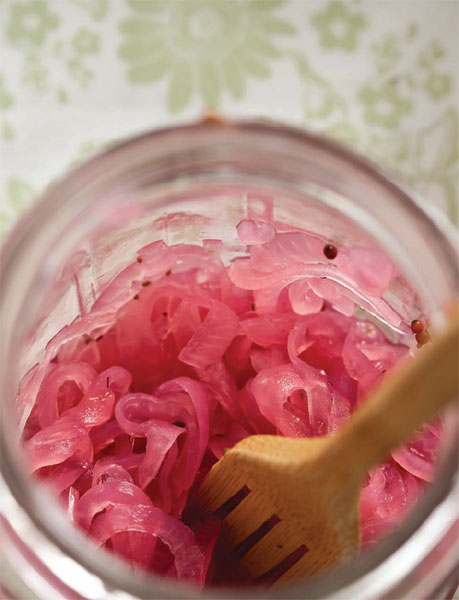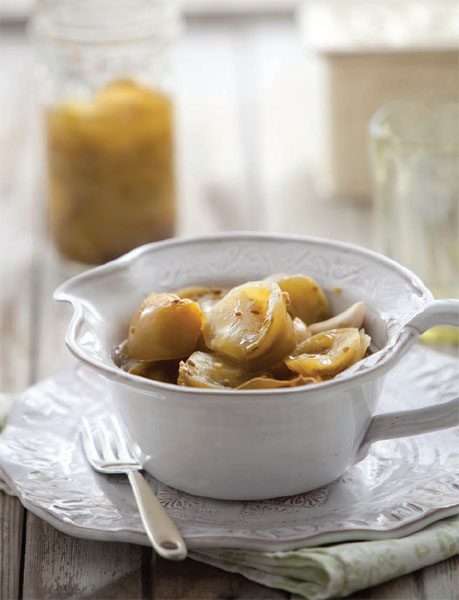Food in Jars (22 page)
Authors: Marisa McClellan
B
RUSSELS SPROUTS ARE ONE OF THE MORE VERSATILE
vegetables out there. Blanched and roasted whole, halved and pan-braised, or shredded and topped with a light dressing, they can easily play a variety of culinary roles. If you haven't done it already, it's time to add “pickled” to the list of Brussels sprouts options. The brine softens them slightly and infuses them with satisfying tartness all the way through.
2 cups/480 ml distilled white vinegar
3 tablespoons pickling salt
8 garlic cloves, peeled
2 teaspoons black peppercorns, divided
2 teaspoons coriander seed, divided
1 teaspoon celery seed, divided
1 teaspoon red pepper flakes, divided
1 teaspoon cumin seed, divided
2 pounds/910 g Brussels sprouts, trimmed and sliced in half
Prepare a boiling water bath and 4 regular-mouth 1-pint/500 ml jars according to the process on page 10. Place the lids in a small saucepan, cover them with water, and simmer over very low heat.
Combine the vinegar, 2 cups/480 ml water, and pickling salt in a pot and bring the brine to a boil.
Meanwhile, add 2 garlic cloves, ½ teaspoon peppercorns, ½ teaspoon coriander seed, ¼ teaspoon celery seed, ¼ teaspoon red pepper flakes, and ¼ teaspoon cumin seed to each sterilized jar.
Pack the sprouts into the jars as tightly as you can manage, but without mangling them.
Slowly pour the hot brine over the Brussels sprouts, leaving ½ inch/12 mm headspace. Gently tap the jars on a towel-lined countertop to help loosen any bubbles before using a wooden chopstick to dislodge any remaining bubbles. Check the headspace again and add more brine if necessary.
Wipe the rims, apply the lids and rings, and process in a boiling water bath for 10 minutes (see
page 11
).
Let these pickles cure for at least 1 week before eating.
Note:
If you're working with fresh-from-the-stalk sprouts, there's no need to cut the little ones in half. Just aim to have everything in a generally uniform size as it goes into the jar.

M
Y MOTHER ADORES BEETS. WHILE SHE WAS PREGNANT
with me, she regularly guzzled Manischewitz borscht straight from the jar. I too am an avowed beet lover. This particular pickle was inspired by a recipe for pickled golden beets that Kevin West posted on his beautiful blog, Saving the Season. I will be forever appreciative for his nudge to spike beet brine with a shot of ginger.
2 pounds/910 g red beets
2 cups/480 ml apple cider vinegar
2 tablespoons pickling salt
1 cup/200 g sugar
1 cinnamon stick
1 (2-inch/5 cm) piece fresh ginger, peeled and thinly sliced
Scrub the beets, removing the greens and long roots. Place the beets in a pot and cover with water. Simmer over medium heat until the beets are just tender, about 30 to 45 minutes depending on the size of your beets. Drain and rinse with cold water. When the beets are cool enough to handle, rub the skins off with your fingers. (Wear plastic gloves or resealable plastic bags on your hands if you're averse to pink-stained skin.) Trim the unwieldy ends, cut the beets into wedges, and set aside.
Prepare a boiling water bath and 4 regular-mouth 1-pint/500 ml jars according to the process on page 10. Place the lids in a small saucepan, cover them with water, and simmer over very low heat.
Combine the vinegar, 2 cups/480 ml water, salt, sugar, cinnamon stick, and ginger slices in a pot and bring the brine to a boil.
Meanwhile, pack the beet wedges into the sterilized jars. Slowly pour the hot brine over the beets in each jar (making sure to include 2 to 3 ginger slices in each jar), leaving ½ inch/12 mm headspace. Gently tap the jars on a towel-lined countertop to help loosen any bubbles before using a wooden chopstick to dislodge any remaining bubbles. Check the headspace again and add more brine if necessary.
Wipe the rims, apply the lids and rings, and process in a boiling water bath for 10 minutes (see
page 11
).
Let these pickles cure for at least 1 week before eating.



I
F YOU WERE TO PLOT CONDIMENTS ON A FAMILY TREE,
you'd find that these pickled red onions are the wild-child granddaughter of caramelized onion jam and the second cousin of the hot dog relish you find at the ball park. They are sophisticated, a little bit slippery, and equally at home draped across a hamburger or dolloped on a salad of baby arugula.
2 cups/480 ml apple cider vinegar
¾ cup/150 g granulated sugar
2 tablespoons pickling salt
3 pounds/1.4 kg red onions, trimmed and thinly sliced
2 teaspoons mustard seed
1 teaspoon celery seed
½ teaspoon red pepper flakes
Prepare a boiling water bath and 3 regular-mouth pint jars according to the process on page 10. Place the lids in a small saucepan, cover them with water, and simmer over very low heat.
Combine the vinegar, 1½ cups/360 ml water, sugar, and salt in a pot over high heat and bring the brine to a boil.
Add sliced onions to brine and stir to combine. Reduce heat to medium and simmer briefly to soften onions.
Meanwhile, combine the remaining spices in a small bowl and stir to blend. Add the spice blend to the sterilized jars, distributing evenly.
Using tongs, evenly divide the onions between the 3 jars. Pour hot brine into each jar, leaving ½ inch/12 mm headspace. Gently tap the jars on a towel-lined countertop to help loosen any bubbles before using a wooden chopstick to dislodge any remaining bubbles. Check the headspace again and add more brine if necessary.
Wipe the rims, apply the lids and rings, and process in a boiling water bath for 10 minutes (see
page 11
).
Let these pickles cure for at least 48 hours before eating.

G
RDENERS NEVER KNOW WHETHER THEY'LL HAVE
a bumper crop of ripe tomatoes or gallons of green tomatoes issuing forth from their plants. This recipe transforms what could be a massive disappointment into something tasty.
1 cup/240 ml distilled white vinegar
1 tablespoon pickling salt
6 garlic cloves, peeled
3 teaspoons dill seed, divided
¾ teaspoon peppercorns, divided
3 bay leaves
2 pounds/910 g green tomatoes, stemmed and cut into wedges
2 pounds/910 g green tomatoes, stemmed and cut into wedges
Prepare a boiling water bath and 4 regular-mouth 1-pint/500 ml jars according to the process on page 10. the process on page 000. Place the lids in a small saucepan, cover them with water, and simmer over very low heat.
Combine the vinegar, 1 cup/240 ml water, and the pickling salt in a pot and bring the brine to a boil.
Meanwhile, add 2 garlic cloves, 1 teaspoon dill seed, ¼ teaspoon peppercorns, and 1 bay leaf to each sterilized jar. Pack the tomato wedges into the jars as tightly as you can manage, while trying not to mangle them.
Slowly pour the hot brine over the tomatoes in each jar, leaving ½ inch/12 mm headspace. Gently tap the jars on a towel-lined countertop to help loosen any bubbles before using a wooden chopstick to dislodge any remaining bubbles. Check the headspace again and add more brine if necessary.
Wipe the rims, apply the lids and rings, and process in a boiling water bath for 10 minutes (see
page 11
).
Let these pickles cure for at least 1 week before eating.
